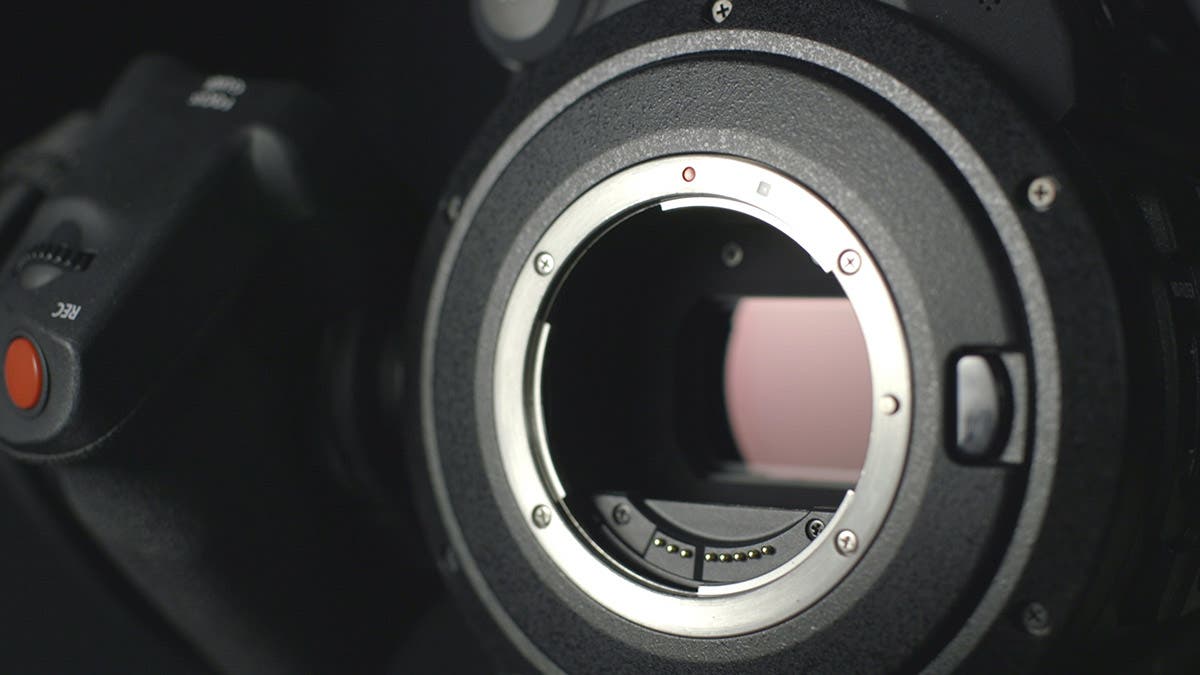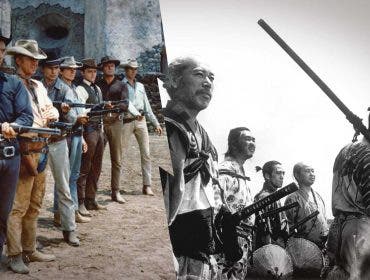Not all cameras are created equal. An entry-level DSLR won’t give you the same results from a professional, full-frame DSLR—even if they have exactly the same pixel count. If you want to get the highest-quality images with your camera, you’ll need something with extremely powerful specifications and a physically large image sensor.
How does a camera sensor work?
Essentially, a sensor is made up of tiny individual photosites. Think of each photosite as a bucket covered by a lid. When an exposure is initiated (press of the shutter button), the lid is uncovered to collect photons of light. When the exposure stops, the lid is placed back on the buckets (photosites). The collected photons are then converted to electrical signal, and the strength of that signal is determined by how many total photons were collected.
As an additional layer of complexity, each bucket has a filter on it that only lets in red, green, or blue light. In essence, each bucket can only collect 1/3 of the total light trying to enter it. For each bucket, the amount of the other colors is approximated. All this information is then converted to the final image you see on your screen.
Why is sensor size important?
A camera’s sensor dictates the quality of the images it can produce—the larger the sensor, the higher the image quality. Bigger image sensors have bigger pixels, which means better low-light performance, reduced noise, good dynamic range, and the ability to obtain more information.
As a photographer, it’s important to know the difference between camera sensor sizes, particularly if you’re planning on buying a new camera. Sensor size is the first and most important thing you need to consider. It is the main feature of your camera that will have the most powerful impact on your images.
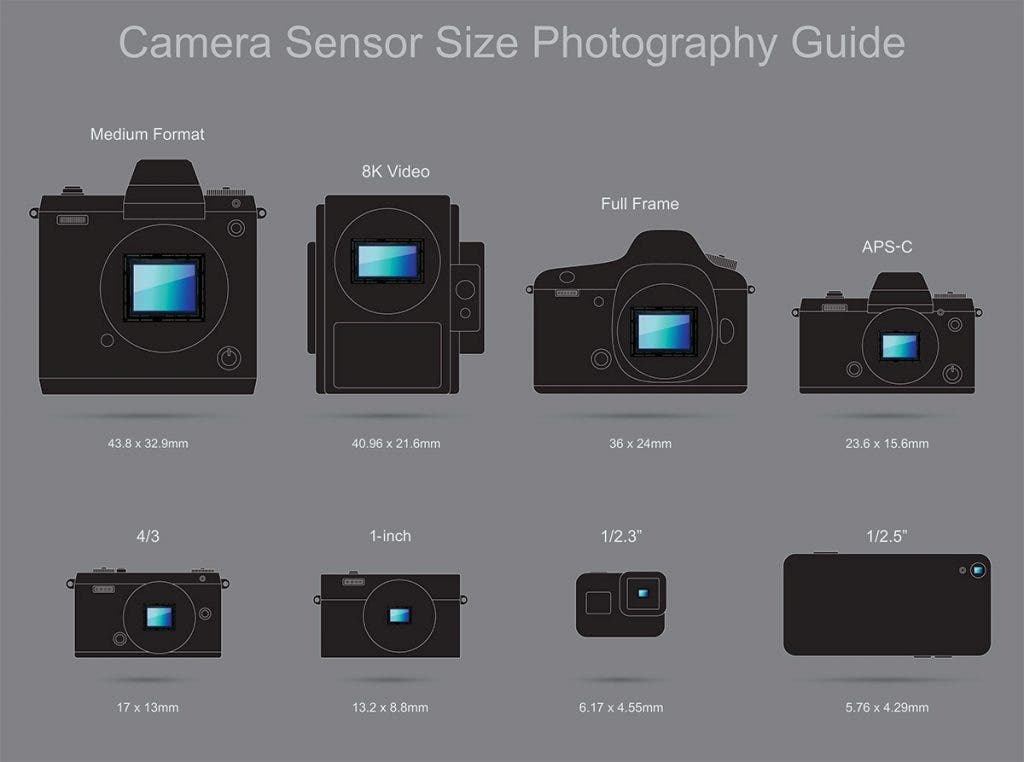
Digital Camera Sensor Size Comparison
Many digital cameras are commercially available on the market right now, and they all have a wide range of sensor sizes. And while it’s good to have choices, it can also get pretty confusing, especially to a beginner.
We’ve all heard of the full-frame DSLR camera, of course, which is the gear of choice of seasoned professional photographers. For enthusiasts and beginners, the usual choice is the APS-C format or crop-sensor DSLR camera. However, some prefer to use mirrorless cameras or MILCs, which are the smaller, lighter versions of DSLRs. Lastly, there are the 1-inch sensor cameras, which are better known as point-and-shoot or compact digital cameras.
There’s also the medium-format cameras—the lesser known of the group. These cameras have the largest sensors out of all the available digital cameras for photography, which means they can get pretty expensive.
So how does each sensor type differ from the rest? Let’s compare.
Camera Sensor Size Comparison Table
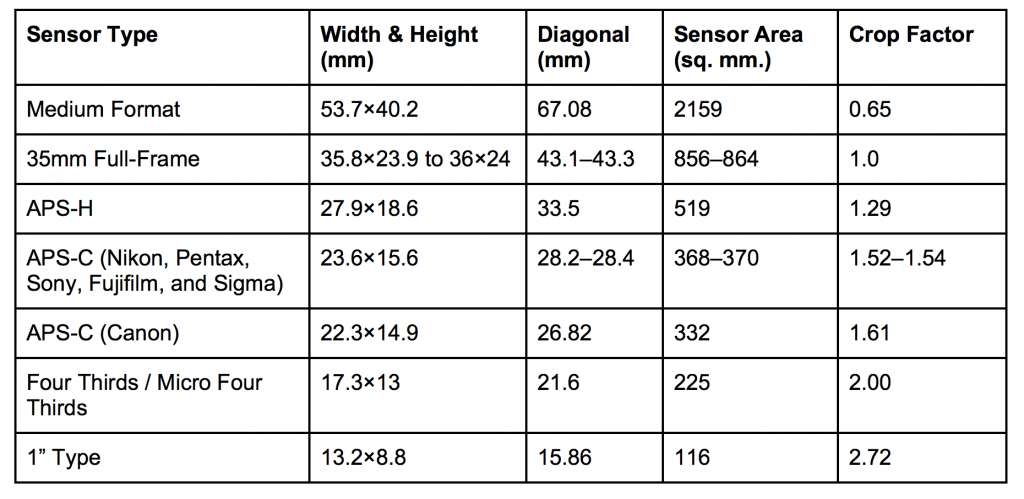
Keep in mind that camera sensor formats are not standardized across the different brands or models. Dimensions may vary slightly from the figures listed above.
Here is a diagram to help you visualize the size difference between the most common camera sensor types:
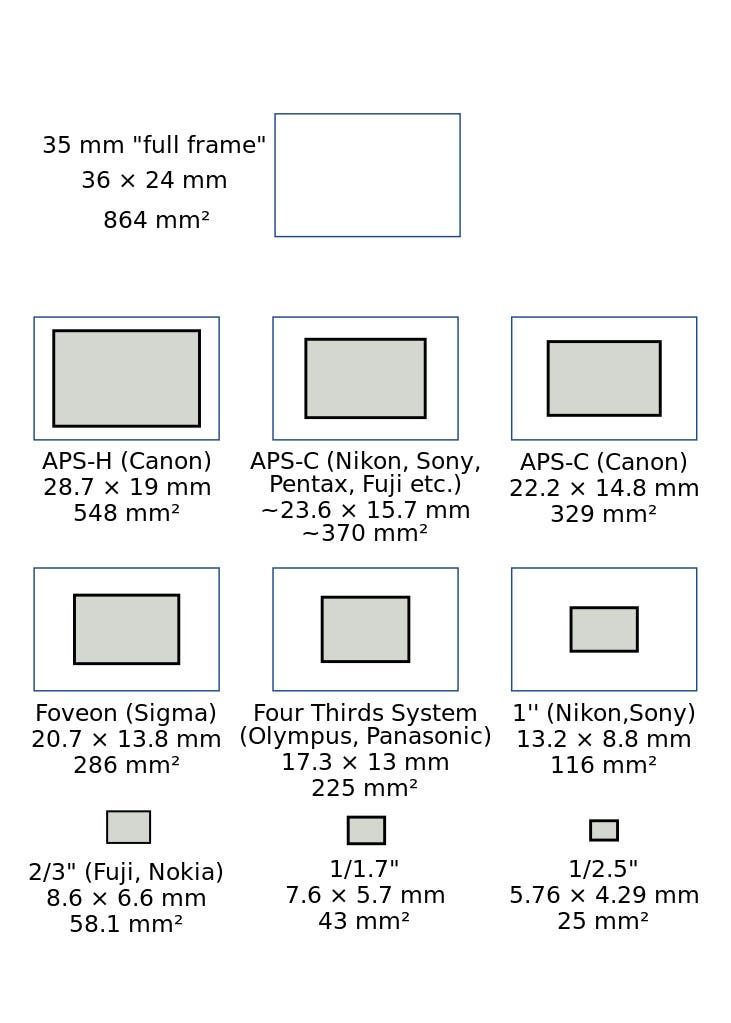
Digital Camera Sensor Types
Medium Format
Medium format is the largest sensor type in digital cameras for photographic applications. However, it doesn’t come in just one size. Medium format has its own group of sensors, with its own equivalents to the four thirds, APS-C, and full-frame formats. There are a variety of sensor sizes for medium-format cameras, and typical sizes range from around 43.8×32.9mm to 53.7×40.2mm.
Due to their large image sensors, medium-format cameras are traditionally heavier and bulkier than their full-frame counterparts. But that changed, as brands like Hasselblad have come out with smaller mirrorless medium-format cameras like the X1D II to provide photographers with a lighter, more compact option. The newer Fujifilm GFX 100 is also a medium-format mirrorless camera and holds a whopping 102MP resolution.
35mm Full-Frame
Full-frame sensors are available in both DSLR and mirrorless cameras. They have the same dimensions as the 35mm film, hence the name. The 35mm full-frame sensor type is the gold standard among professional photographers who want the highest-quality images.
The dimensions of a 35mm sensor are typically 36×24mm.
The Canon EOS R5, for example, is a full-frame mirrorless camera option, and the popular Nikon D850 DSLR has a FX full-frame sensor.
APS-H
The groundbreaking EOS-1D was the first Canon camera to carry the APS-H sensor type was, and it launched in 2001. Canon released four more cameras (all members of the 1D line) with the same sensor type before discontinuing it.
The APS-H is slightly larger than the APS-C sensor format that many Canon DSLR cameras use today but smaller than a traditional full-frame sensor.
APS-C
The APS-C or crop-sensor format is the most well-known and most versatile of the bunch. The APS-C sensor is popular in DSLR and mirrorless cameras alike. Beginners and professionals alike use it thanks to its adaotability.
The typical APS-C sensor size is different across camera brands. Canon APS-C sensors are usually 22.3×14.9mm, while other brands like Nikon, Sony, Pentax, and more usually feature APS-C sensors with 23.6×15.6mm dimensions. Many cameras including the Canon EOS M50 Mark II, Fujifilm X100V, Sony Alpha a6600, and Nikon Z50 all hold APS-C sensors.
Four Thirds/Micro Four Thirds
Created by Olympus and Panasonic, the Four Thirds System is a standard that allows for the compatibility of lenses and bodies across participating camera makers. Image sensor size is 17.3×13mm with a crop factor of 2.0 when compared to full-frame camera sensors.
On the mirrorless camera side, we have the Micro Thirds Format System, first released in 2008. It shares the Four Thirds System’s sensor size and specifications but uses a compact design with no space for the movable mirror, pentaprism, and other parts of the DSLR mechanisms not found in mirrorless cameras.
The Four Thirds System uses a 4:3 image aspect ratio, hence the name, and is featured in cameras like the Blackmagic Design Pocket Cinema Camera 4K. The Micro Four Thirds System uses the same ratio but can also record 16:9, 3:2, and 1:1 formats. It is included in cameras like the Olympus OM-D E-M1 Mark III and Panasonic Lumix G9.
1” Type (and below)
Any sensor that is about 1.5 to 1-inch in size or smaller can be found in non-interchangeable lens cameras (your typical point and shoot) and smartphone cameras.
High-end compact cameras like the Panasonic Lumix DMC-LX10 and the Sony Cyber-Shot DSC-RX10 IV use 1-inch sensors. This allows these cameras to produce good results—in terms of image and video quality—that you won’t get with regular point-and-shoot cameras.
Camera Sensor Sizes Frequently Asked Questions
Is a bigger camera sensor better?
The answer to this question isn’t a simple yes or no. It all depends on what’s most important to you. In general, the larger the sensor the better the image quality because it can acquire more light, generates less noise, and can create a shallower depth of field (more background blur) which is preferred my many for portraiture work.
However, a smaller sensor allows added reach (zoom). For example, on a micro 4/3 sensor, which is has a crop factor of two compared to a full frame sensor, a 200mm lens becomes the equivalent of a 400mm lens. Smaller sensors also allow for an overall more compact camera and lens system, which is convenient for travel and long hikes. Finally, smaller sensor cameras are generally less expensive.
What is better, CCD or CMOS?
Again, there is no simple yes or no answer to this question. In the last decade or so, CMOS sensors have become a lot more prevalent than CCD sensors. Most consumers cameras and cell phones manufactured today use CMOS sensors. CMOS sensors, in general, use less power, therefore the camera battery will last longer.
Meanwhile, CCD sensors tend to produce less noise which translates to images appearing sharper. This goes hand in hand with CCD sensors being more sensitive in lower light conditions. Because CMOS sensors are much more available and costs less to manufacture than CCD sensors, cameras with CMOS sensors are usually less expensive.
Feature photo via Shutterstock

